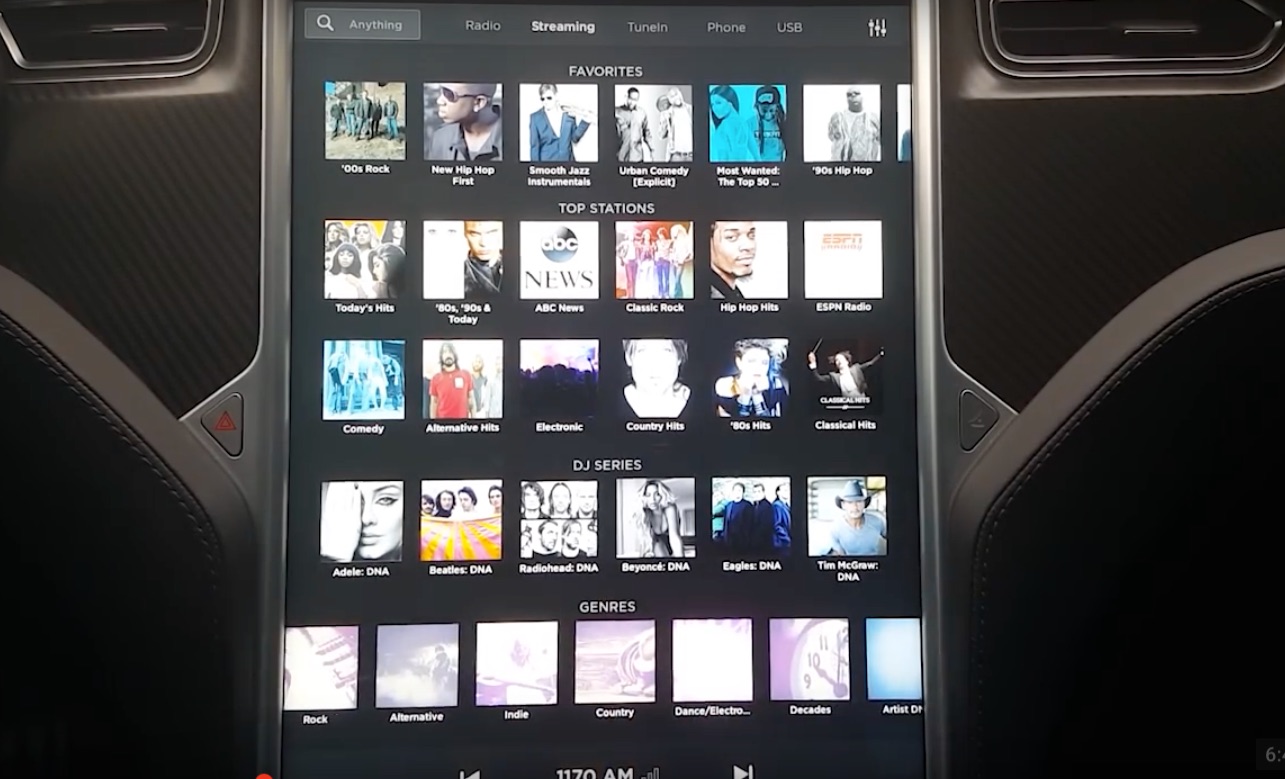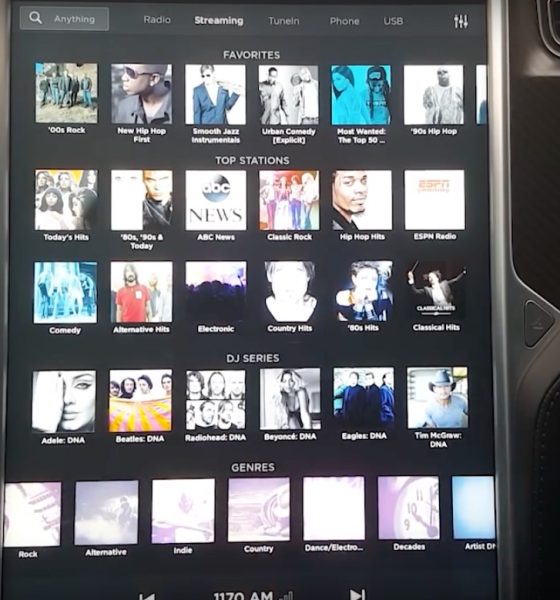

News
Tesla to offer ‘Premium Connectivity’ internet package starting July 1
Tesla will be introducing new cellular connectivity packages for the Model S, Model X, and Model 3 starting July 1. According to the California-based electric car maker, Tesla owners who order their vehicles from July 1 moving forward will have the option to select between a “Premium Connectivity” package and a “Standard Connectivity” package. The new internet packages would be rolled out to all of Tesla’s markets, including Europe, Australia, and Asia.
The Premium Connectivity package includes satellite maps with live traffic visualizations and satellite-view maps. In-car streaming music and media, as well as over-the-air updates via cellular data, are also included in the package, together with other applications and services that are set to be introduced in the future. Full pricing and details are expected to be announced soon, but Tesla expects the internet package to cost roughly $100 per year, or $8.34 per month.
Customers who order a Model S, Model X, or Model 3 with the Premium Interior Package on or after July 1, 2018, will be receiving a year’s worth of Premium Connectivity for free. After the 1-year period is over, owners would be able to select the connectivity package option they prefer. Cars ordered before July 1, including Tesla’s entire fleet today, will not be impacted by the introduction of the new connectivity package options.
Tesla’s Standard Connectivity package includes basic maps and navigation, as well as music and media features through a smartphone’s Bluetooth connection. Over-the-air updates are downloaded through WiFi, though Tesla states that firmware updates related to vehicle safety would be received through cellular at no extra cost. Customers can upgrade to the Premium Connectivity package at any time through the electric cars’ center console.
The main difference between Tesla’s two internet packages lies in live traffic visualization, firmware updates, and in-car streaming. While all vehicles regardless of internet package would feature Tesla’s new and improved Navigation, electric cars with the Standard Connectivity package would not see live traffic visualizations, which are represented by green, orange, and red lines on the vehicle’s maps. The internet browser for the Model S and Model X and music streaming using the car’s cellular data itself would also be unavailable.

Tesla’s improved Navigation, pictured here, would still be accessible to Tesla vehicles with Standard Connectivity packages. [Credit: Black Tesla via YouTube]
Particularly admirable, however, is the fact that all current Teslas on the road today will have the Premium Connectivity package for free for the lifetime of the vehicles. This is a pleasant surprise considering the company’s expectations outlined on its Q4 2013 Shareholder Letter, where Tesla noted that Model S customers would get free data connectivity for four years before the company starts charging for cellular data use.
“To further enhance the driver experience, new Model S customers will now receive free data connectivity and internet radio for four years. As an added benefit to our existing Model S customers, the free four year period starts on January 1, 2014. To be fair to all, in rare cases, a customer may be charged for extreme data use.”
Overall, Tesla’s introduction of its new connectivity packages could be seen as one of the strategies that the company could adopt to achieve its target of hitting profitability by Q3 or Q4 2018. As the size of Tesla’s fleet grows, after all, it becomes more and more costly for the company to provide complimentary cellular internet access to all its vehicles on the road. At around $100 a year or roughly $8.34 per month, Tesla’s Premium Connectivity package is very reasonable, costing less than the price of LTE services for the Apple Watch Series 3, which commands an additional $10 to a mobile phone subscription on AT&T, T-Mobile, and Verizon.

News
Tesla (TSLA) receives “Buy” rating and $551 PT from Canaccord Genuity
He also maintained a “Buy” rating for TSLA stock over the company’s improving long-term outlook, which is driven by autonomy and robotics.

Canaccord Genuity analyst George Gianarikas raised his Tesla (NASDAQ:TSLA) price target from $482 to $551. He also maintained a “Buy” rating for TSLA stock over the company’s improving long-term outlook, which is driven by autonomy and robotics.
The analyst’s updated note
Gianarikas lowered his 4Q25 delivery estimates but pointed to several positive factors in the Tesla story. He noted that EV adoption in emerging markets is gaining pace, and progress in FSD and the Robotaxi rollout in 2026 represent major upside drivers. Further progress in the Optimus program next year could also add more momentum for the electric vehicle maker.
“Overall, yes, 4Q25 delivery expectations are being revised lower. However, the reset in the US EV market is laying the groundwork for a more durable and attractive long-term demand environment.
“At the same time, EV penetration in emerging markets is accelerating, reinforcing Tesla’s potential multi‑year growth runway beyond the US. Global progress in FSD and the anticipated rollout of a larger robotaxi fleet in 2026 are increasingly important components of the Tesla equity story and could provide sentiment tailwinds,” the analyst wrote.
Tesla’s busy 2026
The upcoming year would be a busy one for Tesla, considering the company’s plans and targets. The autonomous two-seat Cybercab has been confirmed to start production sometime in Q2 2026, as per Elon Musk during the 2025 Annual Shareholder Meeting.
Apart from this, Tesla is also expected to unveil the next-generation Roadster on April 1, 2026. Tesla is also expected to start high-volume production of the Tesla Semi in Nevada next year.
Apart from vehicle launches, Tesla has expressed its intentions to significantly ramp the rollout of FSD to several regions worldwide, such as Europe. Plans are also underway to launch more Robotaxi networks in several more key areas across the United States.
News
Waymo sues Santa Monica over order to halt overnight charging sessions
In its complaint, Waymo argued that its self-driving cars’ operations do not constitute a public nuisance, and compliance with the city’s order would cause the company irreparable harm.

Waymo has filed a lawsuit against the City of Santa Monica in Los Angeles County Superior Court, seeking to block an order that requires the company to cease overnight charging at two facilities.
In its complaint, Waymo argued that its self-driving cars’ operations do not constitute a public nuisance, and compliance with the city’s order would cause the company irreparable harm.
Nuisance claims
As noted in a report from the Los Angeles Times, Waymo’s two charging sites at Euclid Street and Broadway have operated for about a year, supporting the company’s growing fleet with round-the-clock activity. Unfortunately, this has also resulted in residents in the area reportedly being unable to sleep due to incessant beeping from self-driving taxis that are moving in and out of the charging stations around the clock.
Frustrated residents have protested against the Waymos by blocking the vehicles’ paths, placing cones, and “stacking” cars to create backups. This has also resulted in multiple calls to the police.
Last month, the city issued an order to Waymo and its charging partner, Voltera, to cease overnight operations at the charging locations, stating that the self-driving vehicles’ activities at night were a public nuisance. A December 15 meeting yielded no agreement on mitigations like software rerouting. Waymo proposed changes, but the city reportedly insisted that nothing would satisfy the irate residents.
“We are disappointed that the City has chosen an adversarial path over a collaborative one. The City’s position has been to insist that no actions taken or proposed by Waymo would satisfy the complaining neighbors and therefore must be deemed insufficient,” a Waymo spokesperson stated.
Waymo pushes back
In its legal complaint, Waymo stated that its “activities at the Broadway Facilities do not constitute a public nuisance.” The company also noted that it “faces imminent and irreparable harm to its operations, employees, and customers” from the city’s order. The suit also stated that the city was fully aware that the Voltera charging sites would be operating around the clock to support Waymo’s self-driving taxis.
The company highlighted over one million trips in Santa Monica since launch, with more than 50,000 rides starting or ending there in November alone. Waymo also criticized the city for adopting a contentious strategy against businesses.
“The City of Santa Monica’s recent actions are inconsistent with its stated goal of attracting investment. At a time when the City faces a serious fiscal crisis, officials are choosing to obstruct properly permitted investment rather than fostering a ‘ready for business’ environment,” Waymo stated.
News
Tesla FSD v14.2.2 is getting rave reviews from drivers
So far, early testers have reported buttery-smooth drives with confident performance, even at night or on twisty roads.

Tesla Full Self-Driving (Supervised) v14.2.2 is receiving positive reviews from owners, with several drivers praising the build’s lack of hesitation during lane changes and its smoother decision-making, among others.
The update, which started rolling out on Monday, also adds features like dynamic arrival pin adjustment. So far, early testers have reported buttery-smooth drives with confident performance, even at night or on twisty roads.
Owners highlight major improvements
Longtime Tesla owner and FSD user @BLKMDL3 shared a detailed 10-hour impression of FSD v14.2.2, noting that the system exhibited “zero lane change hesitation” and “extremely refined” lane choices. He praised Mad Max mode’s performance, stellar parking in locations including ticket dispensers, and impressive canyon runs even in dark conditions.
Fellow FSD user Dan Burkland reported an hour of FSD v14.2.2’s nighttime driving with “zero hesitations” and “buttery smooth” confidence reminiscent of Robotaxi rides in areas such as Austin, Texas. Veteran FSD user Whole Mars Catalog also demonstrated voice navigation via Grok, while Tesla owner Devin Olsen completed a nearly two-hour drive with FSD v14.2.2 in heavy traffic and rain with strong performance.
Closer to unsupervised
FSD has been receiving rave reviews, even from Tesla’s competitors. Xpeng CEO He Xiaopeng, for one, offered fresh praise for FSD v14.2 after visiting Silicon Valley. Following extended test drives of Tesla vehicles running the latest FSD software, He stated that the system has made major strides, reinforcing his view that Tesla’s approach to autonomy is indeed the proper path towards autonomy.
According to He, Tesla’s FSD has evolved from a smooth Level 2 advanced driver assistance system into what he described as a “near-Level 4” experience in terms of capabilities. While acknowledging that areas of improvement are still present, the Xpeng CEO stated that FSD’s current iteration significantly surpasses last year’s capabilities. He also reiterated his belief that Tesla’s strategy of using the same autonomous software and hardware architecture across private vehicles and robotaxis is the right long-term approach, as it would allow users to bypass intermediate autonomy stages and move closer to Level 4 functionality.








